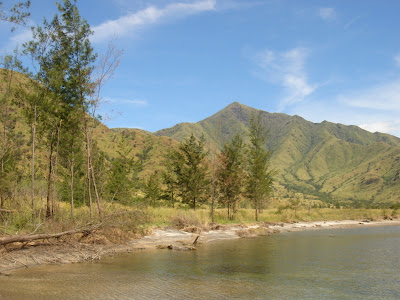Because the tide was still too low for our boat to dock in Camara, we decided to proceed to Nagsasa Cove, a 45-minute boat ride from Capones. Nagsasa is one of four adjacent coves off Pundaquit: the first and nearest being Anawangin, followed by Talisayen Cove (a private property of the America family), Nagsasa and finally, Silanguin, the farthest cove from Pundaquit.
Like Anawangin, Nagsasa has a lagoon (though much cleaner, I suppose) at the back of the beach area that is directly connected to the sea. Surrounded by pointy green mountains and Agoho trees (nope, they are not pine trees), this charming lagoon has that effect of transporting visitors to a far-off place like New Zealand. So if you’re only after the Agoho trees in Anawangin, I suggest you go to Nagsasa instead. But please, bring a trash bag with you and clean up after your mess. We don’t want this magnificent cove to be trashed the same way previous visitors left Anawangin.
The beach area in Nagsasa is much more promising than Capones and Camara, as it is surrounded by towering mountains on all sides. The water is calmer and cleaner here with very minimal waves. Also, there’s a snorkel area about eight feet away from shore (directly north of the comfort room), and you could safely swim around the area wearing only a vest (or even none, if you’re a good swimmer). Although the corals are dead, various tropical seawater fishes add vibrance to the gloomy sight underneah. Too bad though, our Dicapac malfunctioned and busted one of our digicams before we were able to shoot underwater. Boo!
Nagsasa is a feast to the eyes and soul. Its serene environment kept almost in its virginal state, away from the exploiting hands of careless tourists. Soon you’d find that it doesn’t matter if the island doesn’t have electricity or cellphone signal (at least for Sun), because you’ve got everything you need for an exquisite travel right here. Bamboo benches and tables for picnicking from across the sea, a basic comfort room, hammocks to lie on and have a good read at after a great meal, still, clear waters to swim in, disturbances from minimum to bare, a hell of a great view. Time goes unnnoticed in such a simple state.























An extra ordinary places to explore, each picture speak out the beauty.They are awesome island and indescribable beauty.thanks for sharing the picuters with us.
It truly is. Nagsasa is one of the best-kept islands this side of the country. Do drop by for a visit next time!